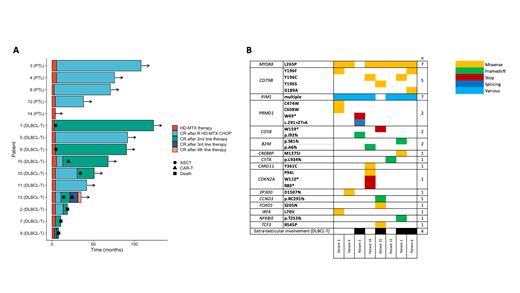Primary testicular lymphoma (PTL) and diffuse large B-cell lymphoma with secondary testicular involvement (DLBCL-T) are rare subtypes of lymphomas associated with poor prognosis and a high risk of central nervous system (CNS) relapse. The optimal CNS prophylaxis strategy for these subtypes remains uncertain. High-dose methotrexate (HD-MTX) is debated for CNS prophylaxis, but its efficacy in this setting is unknown. This study aimed to retrospectively analyze the use of HD-MTX in combination with chemotherapy (R HD-MTX CHOP) as frontline treatment for PTL and DLBCL-T and to compare the biological characteristics of these two forms of testicular involvement.
Data from patients who received R HD-MTX CHOP as first-line treatment for DLBCL-T or PTL between 2010 and 2020 were collected retrospectively. The study included 15 patients, 5 with PTL and 10 with DLBCL-T.
The overall response rate was 86%, with 73% of patients achieving complete remission. Treatment-related adverse events were generally manageable, with febrile neutropenia being the most common. Two patients experienced CNS relapse, both from the DLBCL-T subgroup, with a median time of 10.7 months from diagnosis to CNS relapse. None of the PTL patients receiving HD-MTX experienced relapse during the median follow-up of 6.08 years (Figure 1A), compared to 8/10 DLBCL-T (p=0.007).
All five PTL cases had a non-germinal center phenotype, while 7 out of 10 DLBCL-T cases were non-germinal center. One DLBCL-T case exhibited high-grade lymphoma. Myc expression was positive in 3 out of 10 patients assessed, of whom all were double expressors. Bcl-2 expression was positive in all 13 assessable patients, while Bcl-6 expression was positive in 6 patients.
Myc, Bcl-2, and Bcl-6 rearrangements were assessed in 10 patients and were present in 1 patient who was found to have triple-hit lymphoma. No other patient had double-hit lymphoma or any significant rearrangement. Polysomy of Myc, Bcl-2, and/or Bcl-6 was found in 2 patients. PDL1 expression was observed in one out of six patients analyzed, while no PD1 expression was detected.
In 8 out of 15 patients with available tissue material, next-generation sequencing using a panel targeting 43 lymphoid genes was performed. Among these 8 patients, 87% exhibited gain-of-function mutations in MYD88 (MYD88 L265P), and 62% had missense mutations in CD79B at position Y196. Multiple mutations in the PIM1 gene, a known target of aberrant somatic hypermutation, were also observed in 7 patients. Non-recurrent mutations were detected in various genes, including PRDM1, CD58, B2M, CREBBP, CIITA, CARD11, CDKN2A, EP300, CCDND3, FOXO1, IRF4, NFKBIE, and TCF3 (Figure 1B).
Ig rearrangement was analyzed in 4/9 patients with available DNA. All 4 were clonal, with distinct but mutated VH segments (sequence identity between 81 and 89%).
This study suggests that HD-MTX in combination with RCHOP chemotherapy is highly effective in preventing CNS relapse in PTL but less so in DLBCL-T. DLBCL-T had a higher risk of CNS relapse and poorer outcomes compared to PTL. Further studies are needed to determine the optimal timing and sequence of HD-MTX in DLBCL-T, as well as alternative treatment approaches.
PTL and DLBCL-T have distinct clinical presentations and responses to frontline chemotherapy with HD-MTX prophylaxis. PTL may benefit from HD-MTX in preventing relapse, while alternative treatments should be explored for DLBCL-T. Future studies should consider PTL and DLBCL-T as separate entities to better understand their characteristics and optimize treatment strategies.
Disclosures
No relevant conflicts of interest to declare.


This feature is available to Subscribers Only
Sign In or Create an Account Close Modal